
Concept explainers
(a)
Interpretation:
The products expected when
Concept introduction:
An
All these reactions take place in the presence of basic compounds but in case of
Answer to Problem 9.45AP
The products formed when

Explanation of Solution
The type of reactions those occurs when
The products that are obtained via

Figure 1
The
An
The products formed when
(b)
Interpretation:
The products expected when
Concept introduction:
An alkyl halide in the presence of basic compounds undergoes multiple kinds of reaction, for example,
All these reactions take place in the presence of basic compounds but in case of
Answer to Problem 9.45AP
The products expected when

Explanation of Solution
The type of reactions which
The products that are obtained via

Figure 2
The
An
The products expected when
(c)
Interpretation:
The products expected when
Concept introduction:
An alkyl halide in the presence of basic compounds undergoes multiple kinds of reaction, for example,
All these reactions take place in the presence of basic compounds but in case of
Answer to Problem 9.45AP
The product expected when
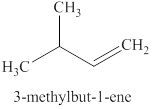
Explanation of Solution
The type of reaction which
The product that is obtained via

Figure 3
An
Only
The product expected when
(d)
Interpretation:
The products expected from the reaction of the product of part (c) and
Concept introduction:
An
Answer to Problem 9.45AP
The products expected from the reaction of the products of part (c) and
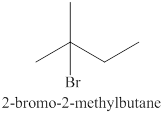
Explanation of Solution
Markonikov’s gave the rule purely on the basis of the observation of products received by him when performed the addition reaction on alkene.
Some reactions do not follow the rule because they follow the stability of the intermediate formed in the mechanism of that particular reaction.
The reaction of an alkene
In the reaction between the product of part (c) and
The products expected from the reaction of the products of part (c) and

Figure 4
The products expected from the reaction of the products of part (c) and
(e)
Interpretation:
The products expected when
Concept introduction:
An alkyl halide in the presence of basic compounds undergoes multiple kinds of reaction, for example,
All these reactions take place in the presence of basic compounds but in case of
Answer to Problem 9.45AP
The products expected when
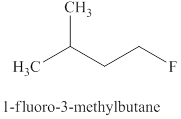
Explanation of Solution
The type of reaction which
The product for the

Figure 5
The
The fluoride ion only undergoes
The products expected when
(f)
Interpretation:
The products expected from the reaction of the product of part (c), chloroform and potassium
Concept introduction:
Answer to Problem 9.45AP
The products expected from the reaction of the product of part (c), chloroform, and potassium
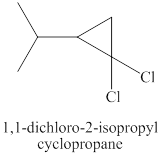
Explanation of Solution
Step-1: Take up of proton to give carbanion.

Figure 6
Step-2: Elimination of chloride ion to give carbene.
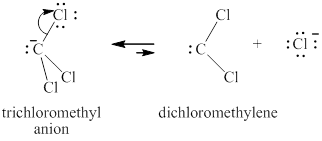
Figure 7
The carbene thus formed adds on the alkene in the leading to no change in the respective stereochemistry of substituents on alkene.
The same reaction is happening when the product of part (c) plus chloroform plus potassium
Therefore, the products expected from the reaction of the product of part (c), chloroform and potassium
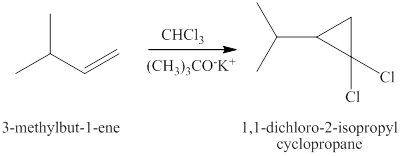
Figure 8
The products expected from the reaction of the product of part (c) chloroform and potassium
(g)
Interpretation:
The products expected from the reaction of the product of part (c) and
Concept introduction:
The reaction of an alkene with the diiodomethane in the presence of
Answer to Problem 9.45AP
The products expected from the reaction of the product of part (c) and
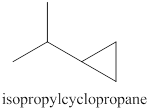
Explanation of Solution
The reaction of the product of part (c) and
The products expected from the reaction of the product of part (c) and

Figure 9
The products expected from the reaction of the product of part (c) and
(h)
Interpretation:
The products expected from the reaction of
Concept introduction:
The reaction of an alkyl halide with a metal like lithium leads to the formation of organolithium compounds (alkyllithium). These compounds are very sensitive to moisture or polar hydrogens reacts immediately leading to the formation of
Answer to Problem 9.45AP
The products expected from the reaction of
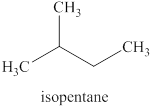
Explanation of Solution
The reaction of an alkyl halide with a metal like lithium leads to the formation of organolithium compounds (alkyllithium), which are highly susceptible to humidity or react to polar hydrogen instantly leading to the alkyl group’s formation. The same reaction is happening in this case.
The products expected from the reaction of

Figure 10
The products expected from the reaction of
(i)
Interpretation:
The products expected when
Concept introduction:
An alkyl halide in the presence of basic compounds undergoes multiple kinds of reaction, for example,
All these reactions take place in the presence of basic compounds but in case of
Answer to Problem 9.45AP
The products expected when

Explanation of Solution
The type of reactions that occurs when
The products that are obtained via

Figure 11
The
An
The products expected when
(j)
Interpretation:
The products expected from the reaction of
Concept introduction:
The reaction of an alkyl halide with a metal like magnesium in the presence of dry ether leads to the formation of
Answer to Problem 9.45AP
The products expected from the reaction of

Explanation of Solution
The reaction of an alkyl halide with a metal like magnesium in the presence of dry ether results in the formation of (organometallic compounds) also known as a Grignard reagent. These compounds are very susceptible to reactions of moisture or polar hydrogen leading to the creation of alkane of the alkyl group instantly. In this case, the same reaction is occurring.
The Grignard reagent obtained in this reaction is isopentylmagnesium bromide and product obtained after treatement with heavy water is deuterated isopentane.
The products expected from the reaction of

Figure 12
The products expected from the reaction of
Want to see more full solutions like this?
Chapter 9 Solutions
Organic Chemistry, Ebook And Single-course Homework Access
- Polymers may be composed of thousands of monomers. Draw three repeat units (trimer) of the polymer formed in this reaction. Assume there are hydrogen atoms there are hydrogen atoms on the two ends of the trimer. Ignore inorganic byproducts please.arrow_forwardi need help with the folarrow_forwardPLEASE HELP NOW! URGENT!arrow_forward
- a. Determine whether each of the Followery Molecules is in the R- On the y- Configuration 1-01"/ 1-6-4 Br 4 I el Br b. Draw The Fisher projection For all the Meso compounds that can exist FOR The Following molenlearrow_forward1- Refer to the monosaccharides below to answer each of the following question(s): CH₂OH CHO CH₂OH CH₂OH 0 H- OH 0 0 HO- H H- -OH HO H HO H H OH HO- H CH₂OH H. OH HO H HO- H CH₂OH CH₂OH CH3 a. Sorbose b. Rhamnose c. Erythrulose d. Xylulose Classify each sugar by type; for example, glucose is an aldohexose. a. Xylulose is .. b. Erythrulose is . c. Sorbose is .. d. Rhamnose is .. 2- Consider the reaction below to answer the following question(s). CHO H OH CH₂OH CH₂OH HO- H HO HO + H. -OH HO OH HO. H OH OH H -OH H OH CH₂OH Q Z a. Refer to Exhibit 25-11. Place a triangle around the anomeric carbon in compound Q. Compound Z is: b. 1. the D-anomer. 2. the a-anomer. 3. the ẞ-anomer. 4. the L-anomer. c. Which anomer is the LEAST stable? d. Q and Z are cyclic examples of: a. acetals b. hemiacetals c. alditols d. hemialditolsarrow_forwardi need help identifying the four carbon oxygen bonds in the following:arrow_forward
- Imagine each of the molecules shown below was found in an aqueous solution. Can you tell whether the solution is acidic, basic, or neutral? molecule HO H3N + The solution is... X O acidic OH O basic H3N-CH-C-O O neutral ○ (unknown) O acidic ○ basic CH2 CH 3-S-CH2 O neutral ○ (unknown) H3N O OH O acidic O basic Oneutral O (unknown) 0 H3N-CH-C-O CH3 CH CH3 O acidic O basic O neutral ○ (unknown) ? olo Ar BHarrow_forwardno Ai walkthroughs need other product (product in picture is wrong dont submit the same thing)arrow_forwardHow to solve this!arrow_forward
 ChemistryChemistryISBN:9781305957404Author:Steven S. Zumdahl, Susan A. Zumdahl, Donald J. DeCostePublisher:Cengage Learning
ChemistryChemistryISBN:9781305957404Author:Steven S. Zumdahl, Susan A. Zumdahl, Donald J. DeCostePublisher:Cengage Learning ChemistryChemistryISBN:9781259911156Author:Raymond Chang Dr., Jason Overby ProfessorPublisher:McGraw-Hill Education
ChemistryChemistryISBN:9781259911156Author:Raymond Chang Dr., Jason Overby ProfessorPublisher:McGraw-Hill Education Principles of Instrumental AnalysisChemistryISBN:9781305577213Author:Douglas A. Skoog, F. James Holler, Stanley R. CrouchPublisher:Cengage Learning
Principles of Instrumental AnalysisChemistryISBN:9781305577213Author:Douglas A. Skoog, F. James Holler, Stanley R. CrouchPublisher:Cengage Learning Organic ChemistryChemistryISBN:9780078021558Author:Janice Gorzynski Smith Dr.Publisher:McGraw-Hill Education
Organic ChemistryChemistryISBN:9780078021558Author:Janice Gorzynski Smith Dr.Publisher:McGraw-Hill Education Chemistry: Principles and ReactionsChemistryISBN:9781305079373Author:William L. Masterton, Cecile N. HurleyPublisher:Cengage Learning
Chemistry: Principles and ReactionsChemistryISBN:9781305079373Author:William L. Masterton, Cecile N. HurleyPublisher:Cengage Learning Elementary Principles of Chemical Processes, Bind...ChemistryISBN:9781118431221Author:Richard M. Felder, Ronald W. Rousseau, Lisa G. BullardPublisher:WILEY
Elementary Principles of Chemical Processes, Bind...ChemistryISBN:9781118431221Author:Richard M. Felder, Ronald W. Rousseau, Lisa G. BullardPublisher:WILEY





